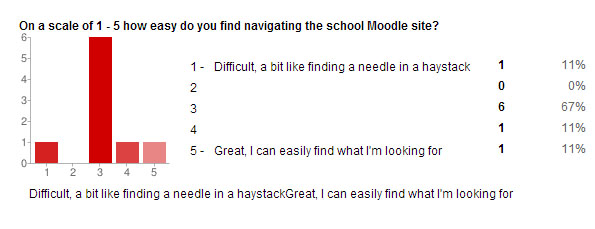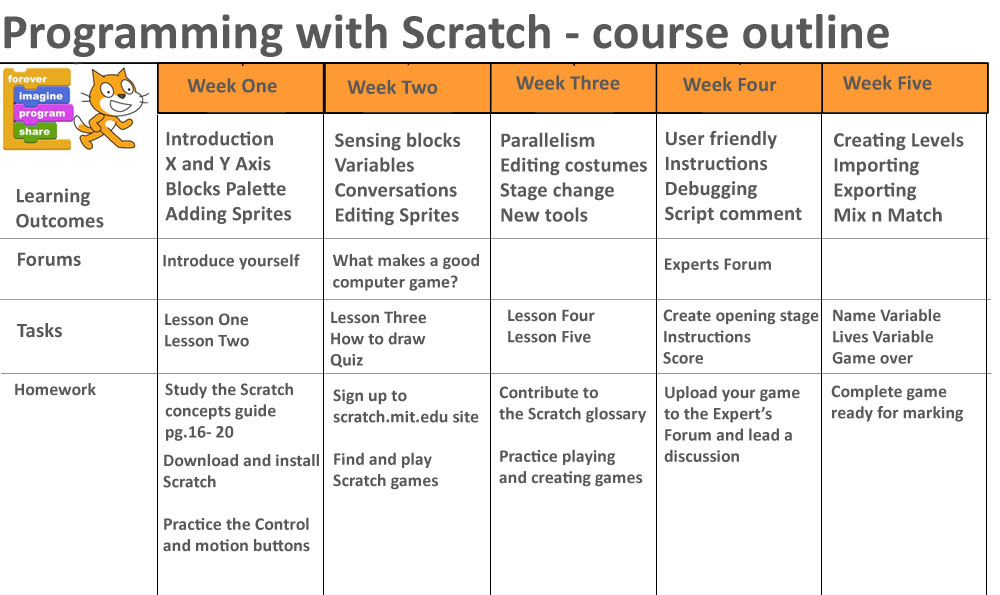The student’s feedback reminds me yet again of the importance of the learning design, visual appearance and the need for straightforward site navigation.
However, with further probing in the survey their comments told a different story;
– Make it easier to find things
– I think it’s good but it’s sometimes hard to find the subjects because there is so many of them all over Moodle
– Sometimes, it’s hard to find what we need
– It was all good
– Have headings that state what term the lessons come from and the week we did them in
– It’s hard to find where some files are
– It’s sometimes hard to find things
In response to that feedback I have drafted up a possible navigation alternative, see below. In this manner students could see at a glance an overview of the course on a week by week basis. Each subheading would be a direct hyperlink to the activity or resource. The downside to this layout is that it appears rather text heavy and if I wanted the theme with two sidebars there would not be a lot of room in the middle section.
Conclusion
I feel this was an ambitious project for me to implement well, given my level of understanding of game design with Scratch and the tight schedule we were working to at school. However, students have done really well in the limited time, to learn the fundamentals of programming, although they are still not quite familiar with computational terms. Next time around, I would make sure I had allowed enough time for students to develop a deeper understanding for programming.
I would like to have the ‘progress’ plug-in installed so student’s could see what tasks they had completed and what they still had to accomplish. The online site which I used previously with my distant student has the plug-in: see the screenshot below.
In my practice, I attempted to employ game design objectives into Moodle as a means to motivate and stimulate student’s interaction, as suggested by Czerkawski, (2012). This will be something I look into further in the future by using conditional formatting and open badges (which Moodle is in the process of developing) as a means to motivate students.
Evidence of Registered Teaching Criteria 1:i
Ongoing Professional Development
Reflecting on this past year and the two teaching pilots I have delivered, I am interested to learn more about the framework behind learning design. How to maximise learning outcomes through the use of interactivity and how to create electronic educational resources that engage students and encourages active participation. Wang, H. (2012) reminds us that the success of interactive learning design rests on the merit of meta-cognitive thinking rather than the ‘physical evidence of interactivity’ (pg. 3,).
I also wish to investigate how to incorporate a game’s pedagogy into digital education resources to enhance engagement in learning via a pro-active role in game play. Aubrecht, M. (2012) advocates for the use of games in education to help students understand different perspectives in context and to extend their problem solving ideas as they receive immediate interactive feedback based on their decisions.
References:
Aubrecht, M., (2012) Games in E-learning: How Games Teach and How Teachers Can Use Them
Ohio State University, USA
In Wang H., 2012, Interactivity in E-Learning: Case Studies and Frameworks (Pp.179- 209)
Information Science Reference (an imprint of IGI Global) Hershey, PA 17033
Brophy J,, (2010) Classroom Management as Socializing Students into Clearly Articulated Roles Journal of Classroom Interaction, ISSN 0749-4025 © 2010, Vol 45.1, pages 41-45
Brennan, K., Chung, M., Hawson, J., Gayle, S., 2011
Creative computing: a design-based introduction to computational thinking
Sourced: 20 August from http://scratched.media.mit.edu/sites/default/files/CurriculumGuide-v20110923.pdf
Churches A., (2009)
Bloom’s Digital Taxonomy
Sourced: 24 August 2012 from http://edorigami.wikispaces.com
Czerkawski Betul, Digital Games: Are They the Future of E-Learning Environments?
University of Arizona South, USA
In Wang H., 2012, Interactivity in E-Learning: Case Studies and Frameworks. (Pp.166- 178)
Information Science Reference (an imprint of IGI Global) Hershey, PA 17033
Nicholas, H., & Ng, W. (2009).
Engaging secondary students in extended and open learning supported by online technologies. Journal of Research on Technology in Education, 41(3), 305-328.
Masterman, E., Jameson, J., & Walker, S., (2009, pg.223 -238)
Capturing teachers’ experience of learning design through case studies
Distance Education; Aug 2009;30,2;ProQuest Vol.30.No.2, August 2009,
Rhode, J. F. (2009).
Interaction equivalency in self-paced online learning environments:
an exploration of learner preferences.
The International Review of Research inOpen and Distance Learning, 10(1).
Retrieved from http://www.irrodl.org/index.php/irrodl/article/view/603/1178
Utting, I., Cooper, S., Kolling, M., Maloney, J., Resnick, M., (2010).
Alice, Greenfoot, and Scratch – A Discussion
ACM Transactions on Computing Education, Vol.10, No 4. Article 17, Pub date: November 2010
Wang H., 2012, Interactivity Design in E-Learning: An Integrated Approach
Dakota State University, USA
Interactivity in E-Learning: Case Studies and Frameworks. (Pp.1- 28)
Information Science Reference (an imprint of IGI Global) Hershey, PA 17033



